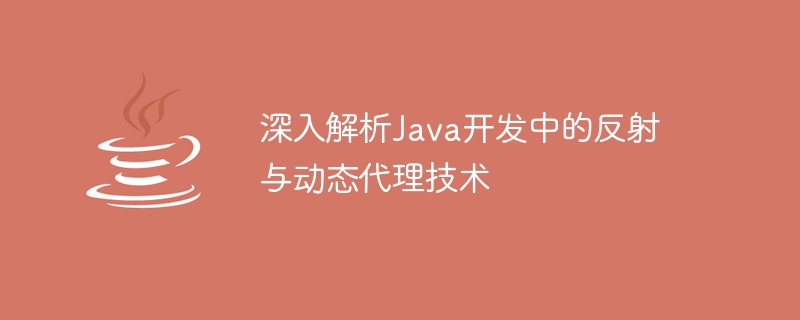Home >Java >javaTutorial >In-depth analysis of reflection and dynamic proxy technology in Java development
In-depth analysis of reflection and dynamic proxy technology in Java development
- WBOYWBOYWBOYWBOYWBOYWBOYWBOYWBOYWBOYWBOYWBOYWBOYWBOriginal
- 2023-11-20 10:00:381283browse

In-depth analysis of reflection and dynamic proxy technology in Java development
Introduction:
In Java development, reflection and dynamic proxy technology are two very important concept. They provide developers with a flexible way to manipulate classes and objects, allowing programs to dynamically obtain and call class information at runtime. This article will provide an in-depth analysis of reflection and dynamic proxy technology in Java development, and analyze its application scenarios and advantages in actual development.
1. The definition and principle of reflection technology
- The concept of reflection
Reflection is a method provided by the Java programming language that can check classes, interfaces, methods and variables at runtime information, and the ability to modify class attributes at runtime. Through reflection, objects can be dynamically created and manipulated, and methods of objects can be called. - The principle of reflection
In Java, reflection is implemented by using the Class object. Each class has a corresponding Class object, and class information, such as the class name, modifiers, fields, methods, and constructors, can be obtained through the methods provided by the Class class. By obtaining the Class object of a class, you can dynamically create objects of the class, call its methods, and access its properties.
2. Application scenarios of reflection technology
- Dynamic creation of objects
Reflection can dynamically create objects at runtime. By obtaining the Class object of the class and using the object's newInstance() method, you can dynamically create an object and call the object's methods. - Dynamic calling method
Through reflection, you can dynamically call the object's method at runtime. By obtaining the Class object of the class and using the getMethod() method of the object, you can obtain the specified method, and then use the invoke() method to call the method. - Accessing and modifying private properties of a class
Reflection technology can bypass the restrictions of access modifiers and access and modify private properties of a class. By obtaining the Class object of the class and using the getDeclaredField() method of the object, you can obtain the specified field, then use the setAccessible() method to remove access restrictions, and finally use the set() method to modify the value of the private property.
3. The definition and principle of dynamic proxy technology
- The concept of dynamic proxy
Dynamic proxy is a technology that dynamically generates proxy classes at runtime. The generated proxy class implements packaging of the target object and can enhance the functionality of the original method without modifying the source code. - The principle of dynamic proxy
In Java, dynamic proxy is implemented by using the Proxy and InvocationHandler interfaces. When using a dynamic proxy to create a proxy object, you need to pass in the target object and the proxy handler that implements the InvocationHandler interface. The proxy handler intercepts method calls to the target object by implementing the invoke() method and performs additional processing before and after the method call.
4. Application scenarios of dynamic proxy technology
- Logging
Dynamic proxy can be combined with reflection technology to record log information before and after method calls to facilitate programmers. Debugging and troubleshooting issues. - Performance Monitoring
Dynamic agents can perform performance monitoring before and after method calls, and collect statistics on the execution time and frequency of methods to optimize program performance. - Transaction Management
Dynamic agents can open and submit transactions before and after method calls to ensure that the method is executed in a transaction.
Conclusion:
Reflection and dynamic proxy technology are important concepts that cannot be ignored in Java development. Through reflection and dynamic proxies, developers can implement dynamic operations on classes and objects, as well as enhance and intercept methods, thereby improving program flexibility and scalability. In actual development, we should make full use of reflection and dynamic proxy technologies, and use them flexibly based on business needs to achieve more elegant and efficient code.
The above is the detailed content of In-depth analysis of reflection and dynamic proxy technology in Java development. For more information, please follow other related articles on the PHP Chinese website!

